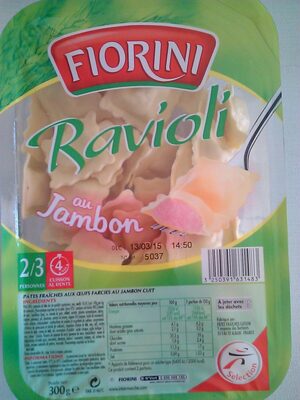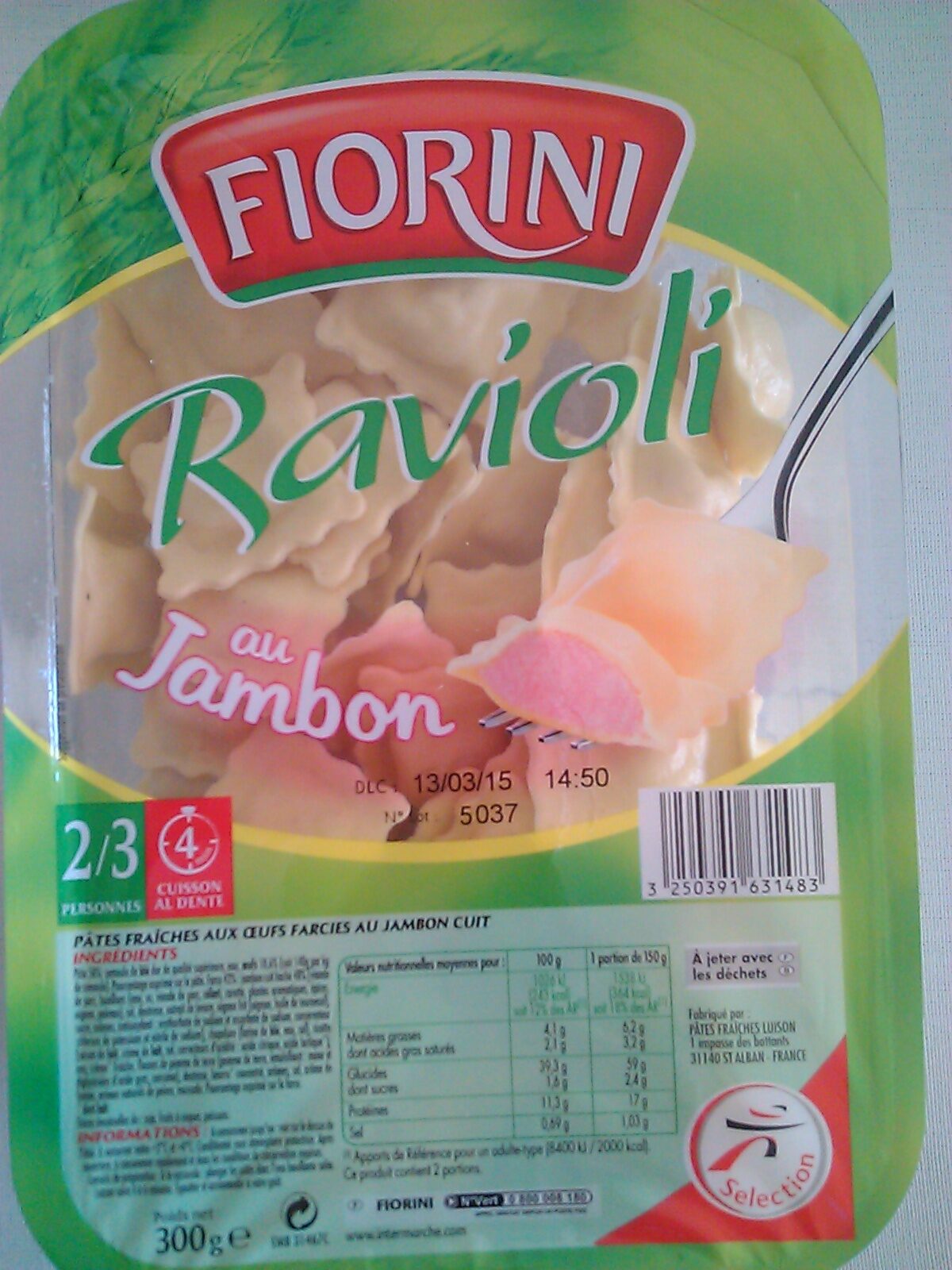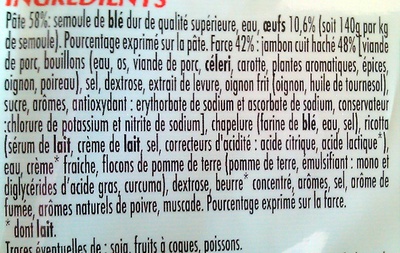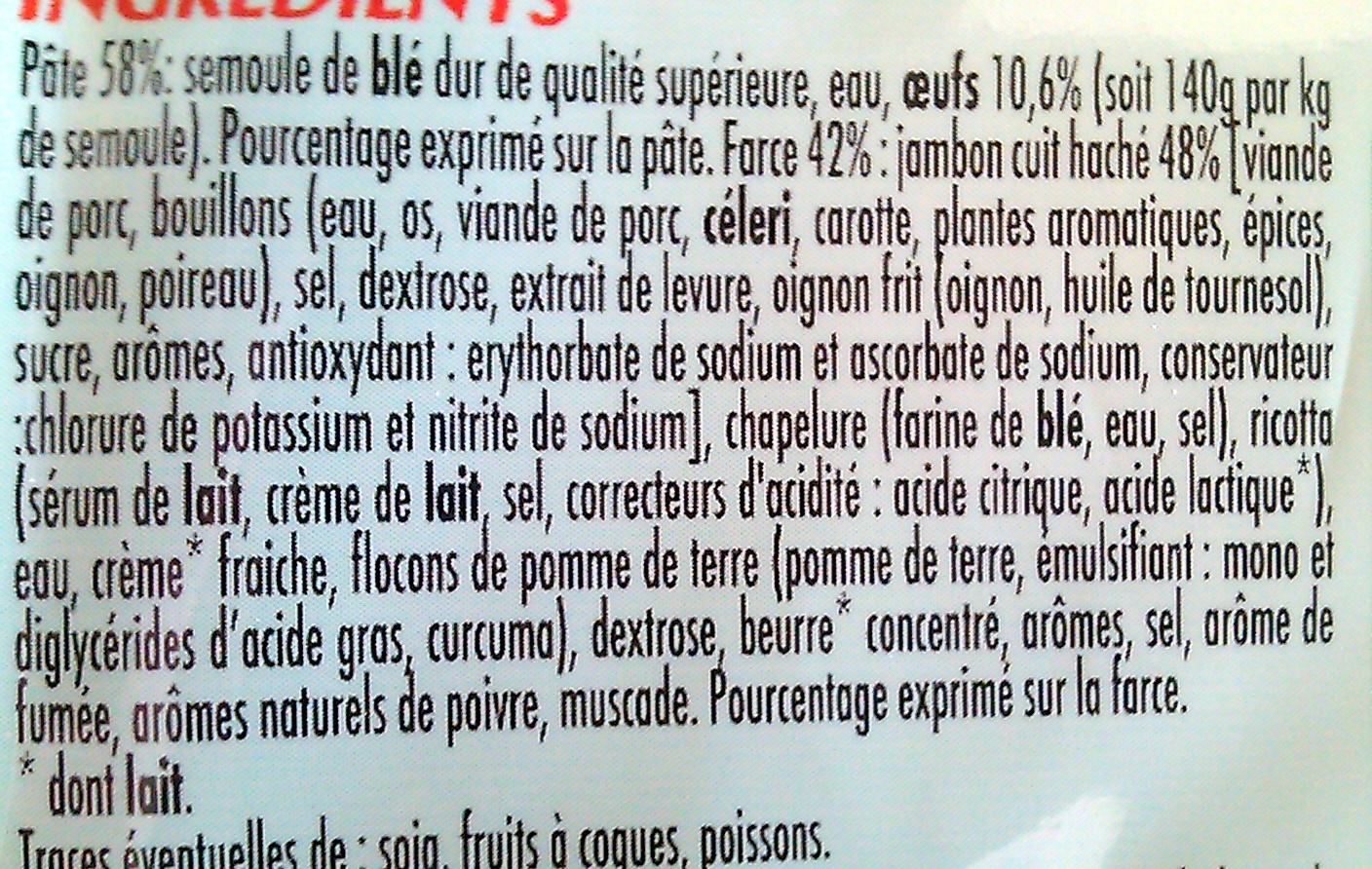Help us make food transparency the norm!
As a non-profit organization, we depend on your donations to continue informing consumers around the world about what they eat.
The food revolution starts with you!
Ravioli au Jambon - Fiorini - 300 g
Ravioli au Jambon - Fiorini - 300 g
This product page is not complete. You can help to complete it by editing it and adding more data from the photos we have, or by taking more photos using the app for Android or iPhone/iPad. Thank you!
×
Some of the data for this product has been provided directly by the manufacturer .
Barcode: 3250391631483 (EAN / EAN-13)
Common name: Ravioli
Quantity: 300 g
Packaging: Plastic, Fresh, Tray
Brands: Fiorini
Categories: Plant-based foods and beverages, Plant-based foods, Meals, Fresh foods, Pasta dishes, Pastas, Stuffed pastas, Fresh meals, Fresh pasta, Pasta stuffed with meat, Ravioli, Fresh ravioli, Meat ravioli, Ham Ravioli
Manufacturing or processing places: Pâtes Fraiches Luison, 1 impasse des battabts, 31140 St Alban, France
Traceability code: EMB 31467C - Saint-Alban (Haute-Garonne, France)
Link to the product page on the official site of the producer: https://www.intermarche.com/
Stores: Intermarché
Countries where sold: France
Matching with your preferences
Health
Ingredients
-
56 ingredients
: Pâte 58% : semoule de blé dur de qualité supérieure, eau, oeuf 10,6% (soit 140g par Kg de semoule). Pourcentage exprimé sur la pâte. Farce 42% : jambon cuit haché 48% [viande de porc, bouillons (eau, os, viande de porc, céleri, carotte, plantes aromatiques, épices, oignon, poireau), sel, dextrose, extrait de levure, oignon frit (oignon, huile de tournesol), sucre, arômes, antioxydant : erythorbate de sodium et ascorbate de sodium, conservateur : chlorure de potassium et nitrite de sodium], chapelure (farine de blé, eau, sel), ricotta (sérume de lait, crème de lait, sel, correcteurs d'acidité : acide citrique, acide lactique), eau, crème fraîche, flacon de pomme de terre (pomme de terre, émulsifiant : mono et diglycérides d'acide gras, curcuma), dextrose, beurre concentré, arôme, sel, arôme de fumée, arômes naturels de poivre, muscade. Pourcentage exprimé sur la farce.Allergens: Celery, Eggs, Gluten, MilkTraces: Fish, Nuts, Soybeans
Food processing
-
Ultra processed foods
Elements that indicate the product is in the 4 - Ultra processed food and drink products group:
- Additive: E471 - Mono- and diglycerides of fatty acids
- Ingredient: Dextrose
- Ingredient: Emulsifier
- Ingredient: Flavouring
- Ingredient: Glucose
Food products are classified into 4 groups according to their degree of processing:
- Unprocessed or minimally processed foods
- Processed culinary ingredients
- Processed foods
- Ultra processed foods
The determination of the group is based on the category of the product and on the ingredients it contains.
Additives
-
E250 - Sodium nitrite
Sodium nitrite: Sodium nitrite is the inorganic compound with the chemical formula NaNO2. It is a white to slightly yellowish crystalline powder that is very soluble in water and is hygroscopic. It is a useful precursor to a variety of organic compounds, such as pharmaceuticals, dyes, and pesticides, but it is probably best known as a food additive to prevent botulism. It is on the World Health Organization's List of Essential Medicines, the most important medications needed in a basic health system.Nitrate or nitrite -ingested- under conditions that result in endogenous nitrosation has been classified as "probably carcinogenic to humans" by International Agency for Research on Cancer -IARC-.Source: Wikipedia
-
E270 - Lactic acid
Lactic acid: Lactic acid is an organic compound with the formula CH3CH-OH-COOH. In its solid state, it is white and water-soluble. In its liquid state, it is colorless. It is produced both naturally and synthetically. With a hydroxyl group adjacent to the carboxyl group, lactic acid is classified as an alpha-hydroxy acid -AHA-. In the form of its conjugate base called lactate, it plays a role in several biochemical processes. In solution, it can ionize a proton from the carboxyl group, producing the lactate ion CH3CH-OH-CO−2. Compared to acetic acid, its pKa is 1 unit less, meaning lactic acid deprotonates ten times more easily than acetic acid does. This higher acidity is the consequence of the intramolecular hydrogen bonding between the α-hydroxyl and the carboxylate group. Lactic acid is chiral, consisting of two optical isomers. One is known as L--+--lactic acid or -S--lactic acid and the other, its mirror image, is D--−--lactic acid or -R--lactic acid. A mixture of the two in equal amounts is called DL-lactic acid, or racemic lactic acid. Lactic acid is hygroscopic. DL-lactic acid is miscible with water and with ethanol above its melting point which is around 17 or 18 °C. D-lactic acid and L-lactic acid have a higher melting point. In animals, L-lactate is constantly produced from pyruvate via the enzyme lactate dehydrogenase -LDH- in a process of fermentation during normal metabolism and exercise. It does not increase in concentration until the rate of lactate production exceeds the rate of lactate removal, which is governed by a number of factors, including monocarboxylate transporters, concentration and isoform of LDH, and oxidative capacity of tissues. The concentration of blood lactate is usually 1–2 mM at rest, but can rise to over 20 mM during intense exertion and as high as 25 mM afterward. In addition to other biological roles, L-lactic acid is the primary endogenous agonist of hydroxycarboxylic acid receptor 1 -HCA1-, which is a Gi/o-coupled G protein-coupled receptor -GPCR-.In industry, lactic acid fermentation is performed by lactic acid bacteria, which convert simple carbohydrates such as glucose, sucrose, or galactose to lactic acid. These bacteria can also grow in the mouth; the acid they produce is responsible for the tooth decay known as caries. In medicine, lactate is one of the main components of lactated Ringer's solution and Hartmann's solution. These intravenous fluids consist of sodium and potassium cations along with lactate and chloride anions in solution with distilled water, generally in concentrations isotonic with human blood. It is most commonly used for fluid resuscitation after blood loss due to trauma, surgery, or burns.Source: Wikipedia
-
E301 - Sodium ascorbate
Sodium ascorbate: Sodium ascorbate is one of a number of mineral salts of ascorbic acid -vitamin C-. The molecular formula of this chemical compound is C6H7NaO6. As the sodium salt of ascorbic acid, it is known as a mineral ascorbate. It has not been demonstrated to be more bioavailable than any other form of vitamin C supplement.Sodium ascorbate normally provides 131 mg of sodium per 1‚000 mg of ascorbic acid -1‚000 mg of sodium ascorbate contains 889 mg of ascorbic acid and 111 mg of sodium-. As a food additive, it has the E number E301 and is used as an antioxidant and an acidity regulator. It is approved for use as a food additive in the EU, USA, and Australia and New Zealand.In in vitro studies, sodium ascorbate has been found to produce cytotoxic effects in various malignant cell lines, which include melanoma cells that are particularly susceptible.Source: Wikipedia
-
E316 - Sodium erythorbate
Sodium erythorbate: Sodium erythorbate -C6H7NaO6- is a food additive used predominantly in meats, poultry, and soft drinks. Chemically, it is the sodium salt of erythorbic acid. When used in processed meat such as hot dogs and beef sticks, it increases the rate at which nitrite reduces to nitric oxide, thus facilitating a faster cure and retaining the pink coloring. As an antioxidant structurally related to vitamin C, it helps improve flavor stability and prevents the formation of carcinogenic nitrosamines. When used as a food additive, its E number is E316. The use of erythorbic acid and sodium erythorbate as a food preservative has increased greatly since the U.S. Food and Drug Administration banned the use of sulfites as preservatives in foods intended to be eaten fresh -such as ingredients for fresh salads- and as food processors have responded to the fact that some people are allergic to sulfites. It can also be found in bologna, and is occasionally used in beverages, baked goods, and potato salad.Sodium erythorbate is produced from sugars derived from different sources, such as beets, sugar cane, and corn. An urban myth claims that sodium erythorbate is made from ground earthworms; however, there is no truth to the myth. It is thought that the genesis of the legend comes from the similarity of the chemical name to the words earthworm and bait.Alternative applications include the development of additives that could be utilized as anti-oxidants in general. For instance, this substance has been implemented in the development of corrosion inhibitors for metals and it has been implemented in active packaging.Sodium erythorbate is soluble in water. The pH of the aqueous solution of the sodium salt is between 5 and 6. A 10% solution, made from commercial grade sodium erythorbate, may have a pH of 7.2 to 7.9. In its dry, crystalline state it is nonreactive. But, when in solution with water it readily reacts with atmospheric oxygen and other oxidizing agents, which makes it a valuable antioxidant.Source: Wikipedia
-
E330 - Citric acid
Citric acid is a natural organic acid found in citrus fruits such as lemons, oranges, and limes.
It is widely used in the food industry as a flavor enhancer, acidulant, and preservative due to its tart and refreshing taste.
Citric acid is safe for consumption when used in moderation and is considered a generally recognized as safe (GRAS) food additive by regulatory agencies worldwide.
-
E471 - Mono- and diglycerides of fatty acids
Mono- and diglycerides of fatty acids (E471), are food additives commonly used as emulsifiers in various processed foods.
These compounds consist of glycerol molecules linked to one or two fatty acid chains, which help stabilize and blend water and oil-based ingredients. E471 enhances the texture and shelf life of products like margarine, baked goods, and ice cream, ensuring a smooth and consistent texture.
It is generally considered safe for consumption within established regulatory limits.
Ingredients analysis
-
May contain palm oil
Ingredients that may contain palm oil: E471, Butterfat
-
Non-vegan
Non-vegan ingredients: Egg, Cooked ham, Pork meat, Bone, Pork meat, Ricotta, Cream, Fresh cream, ButterfatSome ingredients could not be recognized.
We need your help!
You can help us recognize more ingredients and better analyze the list of ingredients for this product and others:
- Edit this product page to correct spelling mistakes in the ingredients list, and/or to remove ingredients in other languages and sentences that are not related to the ingredients.
- Add new entries, synonyms or translations to our multilingual lists of ingredients, ingredient processing methods, and labels.
If you would like to help, join the #ingredients channel on our Slack discussion space and/or learn about ingredients analysis on our wiki. Thank you!
-
Non-vegetarian
Non-vegetarian ingredients: Cooked ham, Pork meat, Bone, Pork meatSome ingredients could not be recognized.
We need your help!
You can help us recognize more ingredients and better analyze the list of ingredients for this product and others:
- Edit this product page to correct spelling mistakes in the ingredients list, and/or to remove ingredients in other languages and sentences that are not related to the ingredients.
- Add new entries, synonyms or translations to our multilingual lists of ingredients, ingredient processing methods, and labels.
If you would like to help, join the #ingredients channel on our Slack discussion space and/or learn about ingredients analysis on our wiki. Thank you!
-
Details of the analysis of the ingredients
We need your help!
Some ingredients could not be recognized.
We need your help!
You can help us recognize more ingredients and better analyze the list of ingredients for this product and others:
- Edit this product page to correct spelling mistakes in the ingredients list, and/or to remove ingredients in other languages and sentences that are not related to the ingredients.
- Add new entries, synonyms or translations to our multilingual lists of ingredients, ingredient processing methods, and labels.
If you would like to help, join the #ingredients channel on our Slack discussion space and/or learn about ingredients analysis on our wiki. Thank you!
: Pâte 58% (semoule de _blé_ dur de qualité supérieure), eau, _oeuf_ 10.6% (), Farce 42% (jambon cuit 48%, viande de porc), bouillons (eau, os, viande de porc, _céleri_, carotte, plantes aromatiques, épices, oignon, poireau), sel, dextrose, extrait de levure, oignon (oignon, huile de tournesol), sucre, arômes, antioxydant (erythorbate de sodium, ascorbate de sodium), conservateur (chlorure de potassium, nitrite de sodium), chapelure (farine de _blé_, eau, sel), ricotta (sérume de _lait_, crème de _lait_, sel, correcteurs d'acidité (acide citrique), acide lactique), eau, crème fraîche, flacon de pomme de terre (pomme de terre, émulsifiant (mono- et diglycérides d'acides gras), curcuma), dextrose, beurre concentré, arôme, sel, arôme de fumée, arômes naturels de poivre, muscade- Pâte -> en:dough - percent: 58
- semoule de _blé_ dur de qualité supérieure -> en:superior-quality-durum-wheat-semolina - vegan: yes - vegetarian: yes - ciqual_food_code: 9610
- eau -> en:water - vegan: yes - vegetarian: yes - ciqual_food_code: 18066
- _oeuf_ -> en:egg - vegan: no - vegetarian: yes - ciqual_food_code: 22000 - percent: 10.6
- Farce -> en:filling - vegan: maybe - vegetarian: maybe - percent: 42
- jambon cuit -> en:cooked-ham - vegan: no - vegetarian: no - ciqual_proxy_food_code: 28205 - percent: 48
- viande de porc -> en:pork-meat - vegan: no - vegetarian: no - ciqual_proxy_food_code: 28205
- bouillons -> en:broth
- eau -> en:water - vegan: yes - vegetarian: yes - ciqual_food_code: 18066
- os -> en:bone - vegan: no - vegetarian: no
- viande de porc -> en:pork-meat - vegan: no - vegetarian: no - ciqual_proxy_food_code: 28205
- _céleri_ -> en:celery - vegan: yes - vegetarian: yes - ciqual_proxy_food_code: 20055
- carotte -> en:carrot - vegan: yes - vegetarian: yes - ciqual_food_code: 20009
- plantes aromatiques -> en:herb - vegan: yes - vegetarian: yes
- épices -> en:spice - vegan: yes - vegetarian: yes
- oignon -> en:onion - vegan: yes - vegetarian: yes - ciqual_food_code: 20034
- poireau -> en:leek - vegan: yes - vegetarian: yes - ciqual_food_code: 20039
- sel -> en:salt - vegan: yes - vegetarian: yes - ciqual_food_code: 11058
- dextrose -> en:dextrose - vegan: yes - vegetarian: yes - ciqual_proxy_food_code: 31016
- extrait de levure -> en:yeast-extract - vegan: yes - vegetarian: yes
- oignon -> en:onion - vegan: yes - vegetarian: yes - ciqual_food_code: 20034
- oignon -> en:onion - vegan: yes - vegetarian: yes - ciqual_food_code: 20034
- huile de tournesol -> en:sunflower-oil - vegan: yes - vegetarian: yes - from_palm_oil: no - ciqual_food_code: 17440
- sucre -> en:sugar - vegan: yes - vegetarian: yes - ciqual_proxy_food_code: 31016
- arômes -> en:flavouring - vegan: maybe - vegetarian: maybe
- antioxydant -> en:antioxidant
- erythorbate de sodium -> en:e316 - vegan: yes - vegetarian: yes
- ascorbate de sodium -> en:e301 - vegan: yes - vegetarian: yes
- conservateur -> en:preservative
- chlorure de potassium -> en:e508 - vegan: yes - vegetarian: yes
- nitrite de sodium -> en:e250 - vegan: yes - vegetarian: yes
- chapelure -> en:breadcrumbs - vegan: maybe - vegetarian: maybe - ciqual_food_code: 7500
- farine de _blé_ -> en:wheat-flour - vegan: yes - vegetarian: yes - ciqual_proxy_food_code: 9410
- eau -> en:water - vegan: yes - vegetarian: yes - ciqual_food_code: 18066
- sel -> en:salt - vegan: yes - vegetarian: yes - ciqual_food_code: 11058
- ricotta -> en:ricotta - vegan: no - vegetarian: maybe - ciqual_food_code: 19585
- sérume de _lait_ -> fr:serume-de-lait
- crème de _lait_ -> en:cream - vegan: no - vegetarian: yes - ciqual_food_code: 19402
- sel -> en:salt - vegan: yes - vegetarian: yes - ciqual_food_code: 11058
- correcteurs d'acidité -> en:acidity-regulator
- acide citrique -> en:e330 - vegan: yes - vegetarian: yes
- acide lactique -> en:e270 - vegan: yes - vegetarian: yes
- eau -> en:water - vegan: yes - vegetarian: yes - ciqual_food_code: 18066
- crème fraîche -> en:fresh-cream - vegan: no - vegetarian: yes - ciqual_food_code: 19402
- flacon de pomme de terre -> fr:flacon-de-pomme-de-terre
- pomme de terre -> en:potato - vegan: yes - vegetarian: yes - ciqual_food_code: 4003
- émulsifiant -> en:emulsifier
- mono- et diglycérides d'acides gras -> en:e471 - vegan: maybe - vegetarian: maybe - from_palm_oil: maybe
- curcuma -> en:turmeric - vegan: yes - vegetarian: yes - ciqual_proxy_food_code: 11089
- dextrose -> en:dextrose - vegan: yes - vegetarian: yes - ciqual_proxy_food_code: 31016
- beurre concentré -> en:butterfat - vegan: no - vegetarian: yes - from_palm_oil: maybe - ciqual_food_code: 16401
- arôme -> en:flavouring - vegan: maybe - vegetarian: maybe
- sel -> en:salt - vegan: yes - vegetarian: yes - ciqual_food_code: 11058
- arôme de fumée -> en:smoke-flavouring - vegan: maybe - vegetarian: maybe
- arômes naturels de poivre -> en:natural-pepper-flavouring - vegan: maybe - vegetarian: maybe
- muscade -> en:nutmeg - vegan: yes - vegetarian: yes - ciqual_food_code: 11048
Nutrition
-
Average nutritional quality
⚠ ️Warning: the amount of fruits, vegetables and nuts is not specified on the label, it was estimated from the list of ingredients: 0This product is not considered a beverage for the calculation of the Nutri-Score.
Positive points: 5
- Proteins: 5 / 5 (value: 11.3, rounded value: 11.3)
- Fiber: 0 / 5 (value: 0, rounded value: 0)
- Fruits, vegetables, nuts, and colza/walnut/olive oils: 0 / 5 (value: 0, rounded value: 0)
Negative points: 8
- Energy: 3 / 10 (value: 1026, rounded value: 1026)
- Sugars: 0 / 10 (value: 1.6, rounded value: 1.6)
- Saturated fat: 2 / 10 (value: 2.1, rounded value: 2.1)
- Sodium: 3 / 10 (value: 276, rounded value: 276)
The points for proteins are counted because the negative points are less than 11.
Nutritional score: (8 - 5)
Nutri-Score:
-
Nutrient levels
-
Fat in moderate quantity (4.1%)
What you need to know- A high consumption of fat, especially saturated fats, can raise cholesterol, which increases the risk of heart diseases.
Recommendation: Limit the consumption of fat and saturated fat- Choose products with lower fat and saturated fat content.
-
Saturated fat in moderate quantity (2.1%)
What you need to know- A high consumption of fat, especially saturated fats, can raise cholesterol, which increases the risk of heart diseases.
Recommendation: Limit the consumption of fat and saturated fat- Choose products with lower fat and saturated fat content.
-
Sugars in low quantity (1.6%)
What you need to know- A high consumption of sugar can cause weight gain and tooth decay. It also augments the risk of type 2 diabetes and cardio-vascular diseases.
Recommendation: Limit the consumption of sugar and sugary drinks- Sugary drinks (such as sodas, fruit beverages, and fruit juices and nectars) should be limited as much as possible (no more than 1 glass a day).
- Choose products with lower sugar content and reduce the consumption of products with added sugars.
-
Salt in moderate quantity (0.69%)
What you need to know- A high consumption of salt (or sodium) can cause raised blood pressure, which can increase the risk of heart disease and stroke.
- Many people who have high blood pressure do not know it, as there are often no symptoms.
- Most people consume too much salt (on average 9 to 12 grams per day), around twice the recommended maximum level of intake.
Recommendation: Limit the consumption of salt and salted food- Reduce the quantity of salt used when cooking, and don't salt again at the table.
- Limit the consumption of salty snacks and choose products with lower salt content.
-
-
Nutrition facts
Nutrition facts As sold
for 100 g / 100 mlAs sold
per serving (150 g)Compared to: Ham Ravioli Energy 1,026 kj
(245 kcal)1,540 kj
(368 kcal)-2% Fat 4.1 g 6.15 g -30% Saturated fat 2.1 g 3.15 g -11% Carbohydrates 39.3 g 58.9 g +5% Sugars 1.6 g 2.4 g -38% Fiber 0 g 0 g -100% Proteins 11.3 g 16.9 g +3% Salt 0.69 g 1.03 g -28% Fruits‚ vegetables‚ nuts and rapeseed‚ walnut and olive oils (estimate from ingredients list analysis) 0 % 0 %
Environment
-
Eco-Score C - Moderate environmental impact
⚠ ️Select a country in order to include the full impact of transportation.The Eco-Score is an experimental score that summarizes the environmental impacts of food products.→ The Eco-Score was initially developped for France and it is being extended to other European countries. The Eco-Score formula is subject to change as it is regularly improved to make it more precise and better suited to each country.Life cycle analysis
-
Average impact of products of the same category: B (Score: 73/100)
Category: Ravioli filled with meat, in tomato sauce, canned
Category: Ravioli filled with meat, in tomato sauce, canned
- PEF environmental score: 0.32 (the lower the score, the lower the impact)
- including impact on climate change: 3.22 kg CO2 eq/kg of product
Stage Impact Agriculture
82.3 %Processing
6.4 %Packaging
5.2 %Transportation
3.9 %Distribution
1.5 %Consumption
0.6 %
Bonuses and maluses
-
Missing origins of ingredients information
Malus: -5
⚠ ️ The origins of the ingredients of this product are not indicated.
If they are indicated on the packaging, you can modify the product sheet and add them.
If you are the manufacturer of this product, you can send us the information with our free platform for producers.
-
Packaging with a medium impact
Malus: -10
Shape Material Recycling Impact 1 Tray PET 1 - Polyethylene terephthalate High 1 Seal PE 7 - Polyethylene High 1 Label Paper Low 1 Label PP 5 - Polypropylene High
Eco-Score for this product
-
Impact for this product: C (Score: 58/100)
Product: Ravioli au Jambon - Fiorini - 300 g
Life cycle analysis score: 73
Sum of bonuses and maluses: -15
Final score: 58/100
-
Carbon footprint
-
Equal to driving 1.7 km in a petrol car
322 g CO² per 100g of product
The carbon emission figure comes from ADEME's Agribalyse database, for the category: Ravioli filled with meat, in tomato sauce, canned (Source: ADEME Agribalyse Database)
Stage Impact Agriculture
82.0 %Processing
6.4 %Packaging
6.0 %Transportation
4.9 %Distribution
0.5 %Consumption
0.2 %
Packaging
-
Packaging with a medium impact
-
Packaging parts
1 x Tray (PET 1 - Polyethylene terephthalate: 16.3 g)
1 x Seal (PE 7 - Polyethylene: 1.9 g)
1 x Label (Paper: 0.6 g)
1 x Label (PP 5 - Polypropylene: 0.8 g)
-
Packaging materials
Material % Packaging weight Packaging weight per 100 g of product Paper or cardboard 3.1% 0.6 g 0.2 g Plastic 96.9% 19 g 6.3 g Total 100% 19.6 g 6.5 g
-
Transportation
-
Origins of ingredients
Missing origins of ingredients information
⚠ ️ The origins of the ingredients of this product are not indicated.
If they are indicated on the packaging, you can modify the product sheet and add them.
If you are the manufacturer of this product, you can send us the information with our free platform for producers.Add the origins of ingredients for this product Add the origins of ingredients for this product
Report a problem
-
Incomplete or incorrect information?
Category, labels, ingredients, allergens, nutritional information, photos etc.
If the information does not match the information on the packaging, please complete or correct it. Open Food Facts is a collaborative database, and every contribution is useful for all.
Data sources
Product added on by dimitri
Last edit of product page on by alexfauquette.
Product page also edited by chevalstar, org-les-mousquetaires, packbot, tacite, teolemon.










